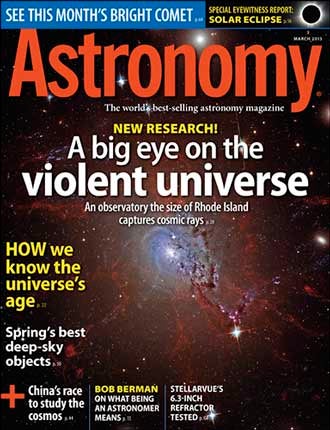
WAUKESHA, Wis. — In the middle of grasslands in Argentina, surrounded by cattle and with the snowcapped Andes Mountains looming to the west, sits a nondescript beige water tank next to a solar panel and antenna. Another such tank appears on the horizon. The sight might seem uninspiring, but these water tanks are actually part of the world’s largest observatory to search for the universe’s most energetic particles — cosmic rays.
Although few people realize it, countless numbers of these subatomic particles bombard our planet every day. Still, because they lack data, scientists don’t know what produces the cosmic-ray energy record holders, which hit Earth much less frequently. Enter the Pierre Auger Observatory.
As Yvette Cendes explains in “A big eye on the violent universe,” the 1,600 cylindrical water tanks that make up the Pierre Auger Observatory produce a flash of light whenever particles from a cosmic-ray air shower streak through. They cover 1,200 square miles (3,000 square kilometers) in order to up the odds of detecting an ultra-high-energy cosmic ray, which on average strikes a square-mile area once every 39 years. And the vastness of the Auger Observatory has helped scientists start to develop ideas about cosmic-ray origins — albeit with a catch. “The only thing is,” Cendes writes, “the first hints appear to be even more perplexing than anyone expected.”
To learn all about the science at the Pierre Auger Observatory and the mysteries still surrounding cosmic rays, pick up the March issue of Astronomy, on newsstands February 5.
“How astronomers know the universe’s age”
How old is the universe? It’s a simple question, but finding the answer is much more complicated. After all, there is no cosmic birth certificate, no document to provide an easy answer. Still, as Associate Editor Liz Kruesi reports in “How astronomers know the universe’s age,” scientists have been able to give the cosmos a moment of birth some 13.77 billion years ago, but it’s taken decades of research to come to such a conclusion — and the most precise method of age determination might surprise you.
“Get ready for Comet PANSTARRS”
A dazzling comet can ignite a viewer’s passion better than almost any other celestial object. And those flames will burn bright this year as 2013 promises not one, but two comets that could reach naked-eye visibility. The first of the year, Comet C/2011 L4 (PANSTARRS) reaches its peak in mid-March and will be a great warm-up for this fall and Comet C/2012 S1 (ISON). In “Get ready for Comet PANSTARRS,” Senior Editor Michael E. Bakich provides an overview of this March solar system visitor and what to expect of it. Remember, comets can be notoriously unpredictable, but you’ll never how great one is — or isn’t — unless you look up.
March sky events visible without optical aid
- March 2 — A waning gibbous Moon passes close to Saturn
- March 9 — Comet C/2011 (PANSTARRS) reaches its closest point to the Sun and should shine brightest around then.
- March 17 — A crescent Moon slides 1.5° south of Jupiter.
- March 29 — The Moon meets Saturn again, this time while appearing much closer to Full phase.
Also in the March 2013 Astronomy
- “China’s race to study the cosmos” — As this eastern nation grows more prosperous, a renewed focus on science moves it closer to the forefront of astronomical research.
- “Explore spring’s best deep-sky objects” — Whether you own a small or large telescope, you’ll experience some terrific celestial treats.
- “A day with two dawns” — Perfect weather on eclipse morning brought stunning views of the solar corona, prominences, and two diamond rings, but it was just one highlight of Astronomy editors’ trips across Australia.
- “Stellarvue’s 6.3-inch refractor field-tested” — Superb optics, high-quality mechanical design, and a top-notch focuser place this apochromat high on any observer’s want list.
- “The Sky this Month” — Exclusive star charts will guide you through March’s night sky.
- The March issue of Astronomy also includes Astro News, Ask Astro, Snapshot, Breakthrough, Bob Berman’s Strange Universe, Stephen James O’Meara’s Secret Sky, Glenn Chaple’s Observing Basics, Tony Hallas’ Cosmic Imaging, Erika Rix’s Astro Sketching, Cosmic World, Letters, Web Talk, New Products, Reader Gallery, and Final Frontier.









